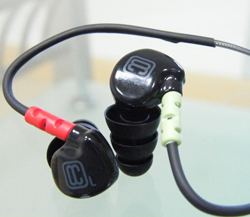
Ambient Earphones
Some manufacturers have attempted to solve the ambience issue by offering an ambient earphone option. There are two types: passive and active, generally available in custom fit versions only.
Passive ambient earphones are essentially the same models sold for full isolation, but altered by drilling a “port” into the plastic shell to let a limited amount of ambient sound to enter the ears acoustically. Inside the port is a fixed 12 dB filter to limit the amount of ambience coming through.
Of course, the louder the stage, the more ambience leaks in, competing with the monitor mix, which must then be adjusted (louder) to suit conditions. On very loud stages, such level could prove harmful, so a plug is provided to close the port in situations where the ambience is too loud, or not desired.
While the passive ambient porting approach is effective in terms of allowing artists to hear stage ambience, it essentially eliminates the primary benefit of isolating earphones.
By adding an ambience port, the noise floor of the listening environment is raised (and thus, the S/N ratio is reduced) by the same amount. This means that the in-ear mix needs to be louder in order to be heard as effectively as without ambience.
As a result, artists using passive ambient earphones can hear the crowd, the stage, and each other, but without the control needed for different stage situations, and without the benefits of true isolation.
Active ambient earphones take a more technical approach. Tiny custom microphones are embedded within the earphones themselves, positioned to create a true binaural listening field. The output from these mics is added to the IEM mix in a bodypack. This is a tricky business, requiring special microphones and circuitry to avoid distortion and provide the same natural sound quality one would hear without earphones.
From a performance perspective, this is the best of both worlds. Full isolation is retained, allowing the artist to “dial in” as much or as little ambience as needed. A simple switch on the bodypack allows the performer to choose between “full ambient” and “perform” modes.
Typically used between songs, full ambient mode is, essentially, like listening without earphones, so performers can speak naturally among themselves, hear the crowd reaction, etc. In “perform” mode, ambience is reduced (or eliminated, if desired), so the artist gets the precise combination of monitor mix and stage ambience he prefers.
There’s no need to remove earpieces between songs, and no reason to engage in the (literally) deafening practice of one ear in, one ear out.
Early adopters of active ambient technology included music directors, who need to communicate with band members on the fly, and guitarists, who often need to hear their amplifiers acoustically as they utilize effects and feedback.
The goal is to provide artists with all the benefit of an isolating system, plus the ability to communicate on stage and hear those adoring fans. Which approach to ambient listening is “right” for your situation? Obviously, it depends on the resources at hand.
Using microphones on a crowd is a limited approach, but works with the tools at hand. Adding additional communication microphones to the artists is an improvement, but very complicated to implement.
Passive ambience is an imperfect solution, but may be right for some artists. The clear gold standard in terms of problem solving is an active ambient IEM system. The price may be high, but those who are using them say they are worth every penny.
Jack Kontney is a long-time pro audio guy and president of Kontney Communications, a content creation and marketing consultancy with a client base that includes Sensaphonics Hearing Conservation.
